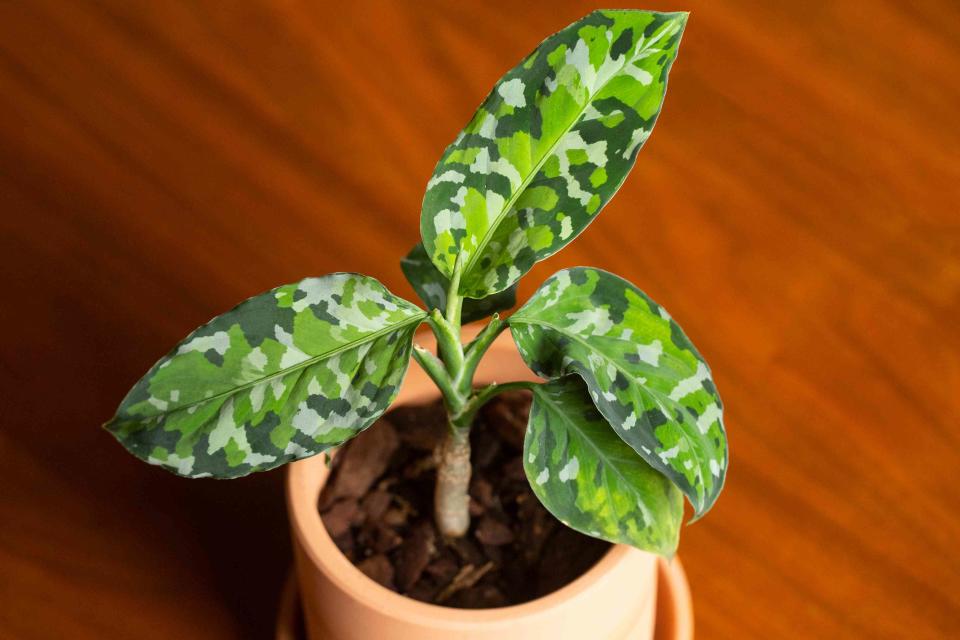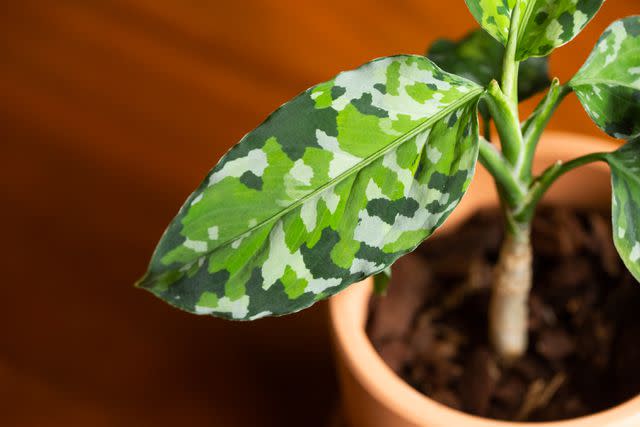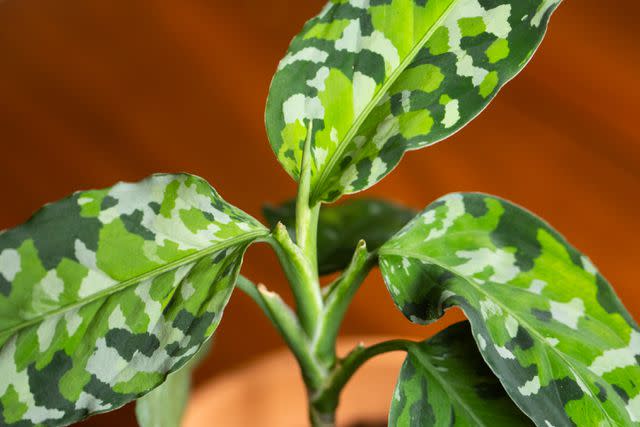How to Grow and Care for Aglaonema Pictum Tricolor
You will definitely want to add this variegated plant to your collection.

The Spruce / Phoebe Cheong
Reviewed by Kathleen Miller
From plants like the elusive Monstera albo to more common choices such as the Philodendron Birkin or Ficus Tineke, variegated houseplants are all the rage right now. So it’s no surprise that the Aglaonema pictum tricolor is hot on many plant lovers’ wish lists right now. A part of the Aglaonema genus (commonly referred to as Chinese evergreens) and the Araceae family, this stunning variegated plant looks almost too good to be true with its glossy, oval leaves and camouflage-like variegation pattern. As its name suggests, this particular variety of the Aglaonema pictum is characterized by three shades of green on its leaves, whereas other similar-looking varieties may only have two shades. Unfortunately, due to its popularity, the Aglaonema pictum tricolor is considered rare and can be hard to find and pricey to acquire. If you have pets, you should also be aware that like all plants in the Aglaonema genus, the pictum tricolor is considered toxic to pets.
Botanical Name | Aglaonema pictum tricolor |
Common Name | Camouflage plant |
Family | Araceae |
Plant Type | Perennial, shrub |
Mature Size | 2 ft. tall (indoors) |
Sun Exposure | Partial |
Soil Type | Moist but well-draining |
Soil pH | Acidic |
Bloom Time | Spring, summer |
Flower Color | Green, white |
Hardiness Zones | 10-12, USA |
Native Area | Asia |
Toxicity | Toxic to pets |
Aglaonema Pictum Tricolor Care
While it can be hard to find, the Aglaoena pictum tricolor is popular as a houseplant and is generally well-suited to indoor growing. Native to subtropical regions across Asia, this highly variegated plant grows naturally as a shrub in the forest understory. As a result, it enjoys dappled light, warm temperatures, and moist, humid conditions. For those who tend to underwater their houseplants, this Aglaonema may not be for you, particularly because of its high price tag (because killing expensive plants is just way more painful). While this shrub flowers readily in its native environment, it is less common for it to flower when grown indoors so don’t worry if your plant isn’t giving you any blooms — its foliage is the true showstopper anyways!

The Spruce / Phoebe Cheong

The Spruce / Phoebe Cheong
Light
This tropical plant does best with several hours of bright, indirect light. Avoid exposing your Aglaonema pictum tricolor to any direct sunlight — particularly harsh afternoon sun — which will burn its variegated leaves. That being said, short periods of morning sunlight, which is less intense than afternoon light, are usually fine.
Soil
As with most plants in the Aglaonema genus, the pictum tricolor appreciates consistently moist conditions but is also sensitive to root rot. This means it should be planted in soil that retains some water while draining well. A porous potting mix amended with plenty of organic materials is ideal. Try making your own at home by combining equal parts indoor potting soil, perlite, and orchid bark mix.
Water
Ideally, Aglaonema pictum tricolor should never be allowed to dry out, although it can withstand short periods of drought if necessary. Water your plant once the top inch of soil has dried out. Always ensure that you allow any excess water to drain from the pot so that the roots are never left sitting in soggy soil, which can lead to root rot.
Temperature and Humidity
This plant is ideally suited to indoor growing because it requires warm, humid conditions in order to thrive. Aglaonema pictum tricolor will not tolerate temperatures below 60 degrees Fahrenheit and enjoys humidity above 65%. This likely means that you will need to place it near a small humidifier or choose a naturally humid room for this plant such as a bathroom. Alternatively, the Aglaonema pictum tricolor is an excellent choice for a greenhouse cabinet plant.
Fertilizer
Fertilize this Aglaonema once every two weeks during the spring and summer with a diluted liquid fertilizer designed for houseplants. Stop fertilizing entirely during the fall and winter once the plant is no longer actively growing.
Text + Image Link:The 15 Best Places to Buy Plants Online in 2023
Propagating Aglaonema Pictum Tricolor
The Aglaonema pictum tricolor can be propagated easily by division and by rooting stem cuttings. This plant has a spreading growth habit, which means that it grows offshoots as it matures. Dividing and potting these offshoots is the easiest way to propagate this Aglaonema, but you can also take stem cuttings from older stems to root if you wish. The latter option may be particularly attractive if your plant has become leggy over time and you wish to clean up its appearance.
To propagate Aglaonema pictum tricolor by division, follow these steps.
Remove your plant from its pot by grabbing it at the base of the stems and gently wiggling it until it comes free.
Identify one or more stems that you would like to separate from the main plant, and using your hands, begin to loosen the soil around these stems, pulling them gently apart from the root clump. Each stem should have some of its own roots when it comes loose. If the stems break off without any of their own roots, follow the steps below for propagating by stem cuttings.
Prepare a small pot with well-draining potting soil and plant the newly separated plants, watering them well after planting.
Put the freshly planted cuttings in a warm, bright location and keep the soil evenly moist.
Return the mother plant back to its original pot and top up the potting soil if necessary.
To propagate Aglaonema pictum tricolor by stem cuttings, follow these steps.
Using a pair of sharp pruning shears or scissors, take stem cuttings with at least 3 to 4 nodes on the stem. The nodes are where leaves and new roots will grow.
Remove the bottom 1 to 2 leaves from each cutting by gently pulling or cutting them off, exposing the stem and the nodes.
Prepare a container with fresh water and place the cuttings in the water so that the stem and exposed nodes are submerged and the remaining leaves at the top of the cutting are above the surface of the water.
Place the container with the cuttings in a warm location that receives bright, indirect light and refresh the water once a week. After a couple of weeks, you should begin to notice white roots growing from the bottom of the stem.
Once the roots are 1 to 2 inches long you can move the cuttings from water back to soil. Prepare a small pot with well-draining potting soil and plant the rooted cuttings, watering them well after planting.
Put the freshly planted cuttings back in the same warm, bright location and keep the soil evenly moist.
Potting and Repotting Aglaonema Pictum Tricolor
These variegated plants are notoriously slow-growing and do not need to be repotted often as a result. Once every 2 to 3 years, or once the plant has outgrown its potting container, is all that is required. Watch out for signs that your plant has outgrown its pot such as roots growing from the drainage holes, or roots circling the inside of the pot. Then, choose a pot that is only 2 to 4 inches larger than its old pot. Moving your plant to a pot that is too large too quickly can result in accidental overwatering.
Common Pests & Plant Diseases
This tropical plant is not particularly prone to any pests or diseases but is susceptible to a few common houseplant pests. Keep an eye out for signs of aphids, mealybugs, and spider mites, and treat your plant with neem oil or an insecticide designed for houseplants if you see any indications of an infestation. Also, be aware that these plants can develop root rot if they are overwatered or left in soggy conditions.
Common Problems With Aglaonema Pictum Tricolor
While Aglaonemas are popular houseplants, they can be finicky if their care needs aren’t met. Keep an eye out for these common problems with the pictum tricolor.
Brown Leaves
Brown leaves are usually a result of underwatering and/or a lack of humidity. Ensure that you are not letting your Aglaonema dry out too much between waterings and give it plenty of humidity where possible. Also, keep it away from drafty air vents that will dry out the air around the plant.
Yellow Leaves
Yellow leaves can be a sign of overwatering, underwatering, lack of light, or too much light – confusing, we know. The only way to figure out exactly what’s going on is to closely examine your plant’s growing conditions. Ideally, it should be placed directly in front of, or pretty close to a bright window. If its set back several feet from the nearest window it is probably not getting enough light. However, make sure that it is not getting hit directly with scorching sunrays which can cause leaf burn. Additionally, the plant’s soil should be consistently moist, not soggy. Wait to water until the top inch or so of soil has dried and then allow all excess water to drain from the pot. Soggy soil is an indication of too much water, while allowing the plant to dry out too much will also cause yellow leaves due to underwatering.
Drooping Leaves
If your Aglaonema pictum tricolor’s leaves are drooping it means that your plant needs to be watered. These plants are known for being a bit dramatic when their care needs aren’t met and will droop readily if they are underwatered. As long as you catch it early enough, your plant should perk back up after a good drink!
Frequently Asked Questions
What is the difference between the Aglaonema pictum bicolor and the Aglaonema pictum tricolor?
As their names suggest, the main difference between these two closely related plants is their coloring. The Aglaonema pictum bicolor only has two colors on its leaves, giving it more of a marbled appearance, while the Aglaonema pictum tricolor has three colors on its leaves and has a more camouflage pattern.
How do you make an Aglaonema pictum tricolor bushier?
The best way to encourage your plant to be full and bushy is to provide it with the proper care and growing conditions. Unlike some other houseplants, pruning will not encourage a fuller growth habit in Aglaonemas. Giving your plant plenty of bright light, fertilizer, and regular watering will result in luscious, healthy growth and a bushy plant.
Where can I buy an Aglaonema pictum tricolor?
These rare houseplants can be hard to find, and it’s probably unlikely that you will just happen upon one at your local greenhouse. You will likely need to source this plant from a houseplant collector or specialty plant shop that deals with rare tropical. Alternatively, Etsy is a great place to check. Just be sure to read reviews and shop policies thoroughly if you plan to order any plant online!

